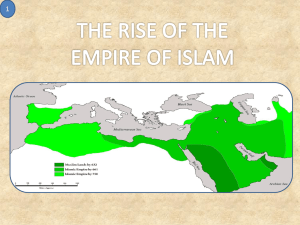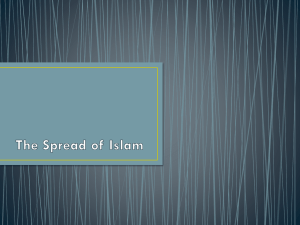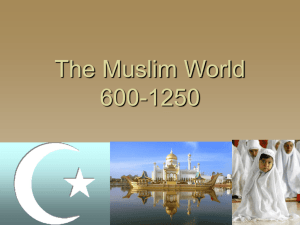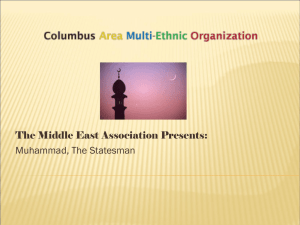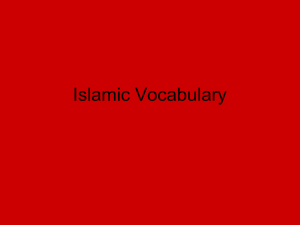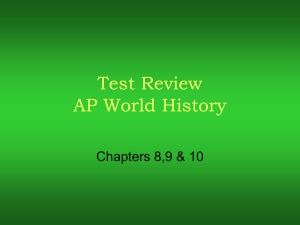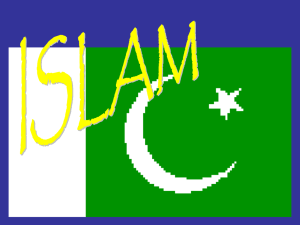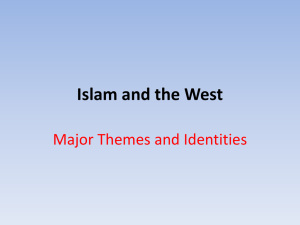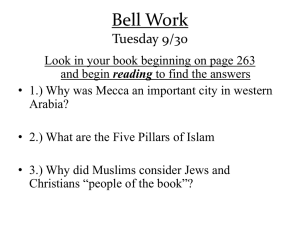File - Mrs. Lucas`s Social Studies Site
advertisement
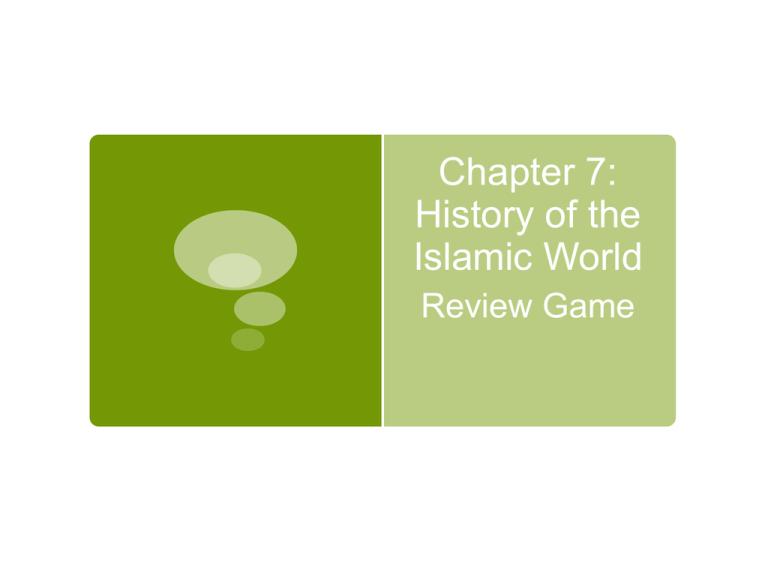
Chapter 7: History of the Islamic World Review Game Question 1: Why do geographers call Arabia a “crossroads” location? A. It is home to very few cultures or people. B. Trade routes linking Africa, Asia, and Europe run through it. C. People from many different cultures live there. D. All trade routes ended in Arabia. Question 1 ANSWER Why do geographers call Arabia a “crossroads” location? ANSWER B Trade routes linking Africa, Asia, and Europe run through it. Question 2: What was the most important difference between Muhammad’s teachings and the beliefs of other Arabs? A. Muhammad taught that people should be kind to the poor. B. Muhammad taught that there was only one God. C. Muhammad taught that there were many gods. D. Muhammad taught that people should make pilgrimages to Kaaba. Question 2 ANSWER What was the most important difference between Muhammad’s teachings and the beliefs of other Arabs? ANSWER B. Muhammad taught that people should be kind to the poor. Question 3: The Sunnah is based on the _______. A. hadith B. Shariah C. Qur’an D. Five Pillars of Islam Question 3 ANSWER: The Sunnah is based on the ______. ANSWER A Hadith. Question 4 Which is the best prediction of what might have happened if the Berbers had kept fighting the Muslims? A. The Berbers would have converted to Christianity instead. B. Muslim rule would have spread more slowly in North Africa. C. The Muslims would have conquered France. D. Berber rule would have spread more quickly in Europe. Question 4 ANSWER Which is the best prediction of what might have happened if the Berbers had kept fighting the Muslims? ANSWER B Muslim rule would have spread more slowly in North Africa. Question 5 Which of the following is true of Muslim art and architecture? A. They became more important than religion in the Muslim world. B. Muslims were only interested in them if they helped spread Islam. C. They were both influenced in some way by the Muslim religion. D. Islam would not have spread without them. Question 5 ANSWER Which of the following is true of Muslim art and architecture? ANSWER C They were both influenced in some way by the Muslim religion. Question 6 Which goal would have been important to nomads? A. getting food and water for their animals B. building large temples C. getting water for their crops. D. collecting spices, gold, and other goods. Question 6 ANSWER Which goal would have been important to nomads? ANSWER A Getting food and water for their animals. Question 7 What content is included in the Qur’an? A. guidelines for moral behavior B. Muhammad’s words and actions C. interpretation of the Sunnah D. description of the life of Muhammad Question 7 ANSWER What content is included in the Qur’an? ANSWER A Guidelines for moral behavior. Question 8 Which of the following is an Islamic belief? A. The Sunnah is the exact word of God. B. Muhammad was the son of God. C. Allah is the only God. D. Muhammad’s house in Medina is Islam’s most sacred place. Question 8 ANSWER Which of the following is an Islamic belief? ANSWER C Allah is the only God. Question 9 After Muhammad’s death, the title given to Islam’s highest leaders was ________. A. successor B. caliph C. sultan D. emperor. Question 9 ANSWER After Muhammad’s death, the title given to Islam’s highest leaders was _____. ANSWER B Caliph Question 10 Muslims initially showed tolerance by ________. A. accepting other people’s religious beliefs. B. converting others to Islam. C. allowing only Christians to practice their religion. D. conquering the Berbers Question 10 Answer Muslims initially showed tolerance by _____. ANSWER A Accepting other people’s religious beliefs. Question 11 Who wrote a medical encyclopedia that was translated into Latin and widely used throughout Europe? A. Ibn Battutah B. Mehmed II C. Omar Khayyam D. Avicenna Question 11 ANSWER Who wrote a medical encyclopedia that was translated into Latin and widely used throughout Europe? ANSWER D Avicenna Question 12 Who was one of the most famous Sufi poets? A. Ibn Battutah B. Mehmed II C. Omar Khayyam D. Avicenna Question 12 ANSWER Who was one of the most famous Sufi poets? ANSWER C Omar Khayyam Question 13 What can you infer about the journey from Ctesiphon to Medina? A. It was slower than a journey from Ctesiphon to Mecca. B. People who made the trip were very wealthy. C. It was a difficult journey through a harsh climate. D. People did not take this route because it was too dangerous. Question 13 ANSWER What can you infer about the journey from Ctesiphon to Medina? ANSWER C It was a difficult journey through a harsh climate. Question 14: A way of life in which people traveled the deserts with their herds in search of food and water is called ______________. Sedentary OR Nomadic Question 14 ANSWER A way of life in which people traveled the deserts with their herds in search of food and water is called NOMADIC. Question 15 _________ was the name of the religion introduced by the prophet Muhammad. Muslims OR Islam Question 15 ANSWER Islam was the name of the religion introduced by the prophet Muhammad. Question 16 ________ refers to the inner struggle people go through in their effort to obey God and behave according to Islamic ways. Allah OR Jihad Question 16 ANSWER Jihad refers to the inner struggle people go through in their efforts to obey God and behave according to Islamic ways. Question 17 The capital of the Ottoman Empire was ____________. Istanbul OR Hagia Sophia Question 17 ANSWER The capital of the Ottoman Empire was Istanbul. Question 18 Muslim advances in ____________ combined new thoughts with Greek and Indian knowledge. Geography OR Medicine Question 18 ANSWER Muslim advances in medicine combined new thoughts with Greek and Indian knowledge. Question 19 Belonging to a tribe offered nomads safety from desert dangers. TRUE Or FALSE Question 19 ANSWER TRUE Belonging to a TRIBE did offer nomads safety from desert dangers. Question 20 The first year of the Islamic calendar is the year of Muhammad’s PILGRIMAGE, or journey from Mecca to Medina. Is Pilgrimage the correct word? TRUE Or FALSE Question 20 ANSWER FALSE The first year of the Islamic calendar is the year of Muhammad’s HEGIRA, or journey from Mecca to Medina. Question 21 Baghdad was an impressive Muslim city in Europe in the 900s. TRUE Or FALSE Question 21 ANSWER FALSE CORDOBA was an impressive Muslim city in Europe in the 900’s. Question 22 Muslims study the HADITH, which is a written record of Muhammad’s words and actions. TRUE Or FALSE Question 22 ANSWER TRUE The hadith is a written record of Muhammad’s words and actions. Question 23 Three major Muslim empires were the Ottoman Empire, the SHARIAH Empire, and the Mughal Empire. TRUE OR FALSE Question 23 ANSWER FALSE The three major Muslim empires were Ottoman, SAFAVID, and Mughal empires. Question 24 What was the title used by Persian kings? Question 24 ANSWER SHAH Question 25 What is a “slave soldiers trained by the Ottomans? Question 25 ANSWER Janissaries Question 26 What is the “five acts of worship required of all Muslims”? Question 26 ANSWER FIVE PILLARS OF ISLAM Question 27 What word means “to make an effort, or to struggle”? Question 27 ANSWER Jihad Question 28 What word means “decorative writing?” Question 28 ANSWER Calligraphy Question 29 What word means “acceptance?” Question 29 ANSWER Tolerance Question 30 What word means “building for Muslim prayer”? Question 30 ANSWER Mosque Question 31 What word means “a title that Muslims use for the highest leader of Islam”? Question 31 ANSWER Caliph Question 32 What is a “common feature of Muslim architecture”? Question 32 ANSWER Minaret Question 33 What word means a “journey to a sacred place”? Question 33 ANSWER Pilgrimage
